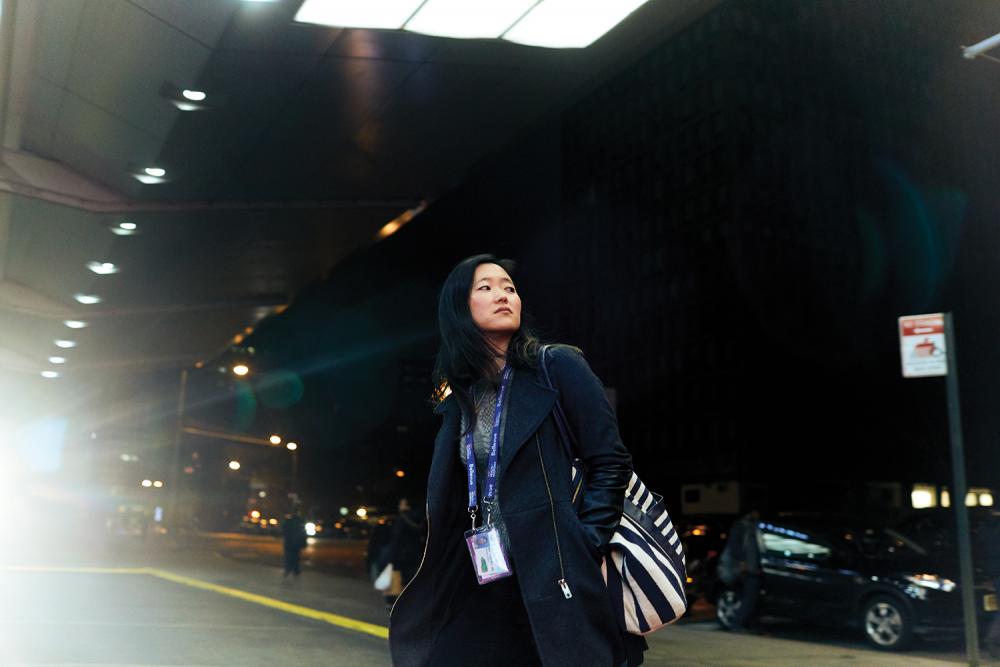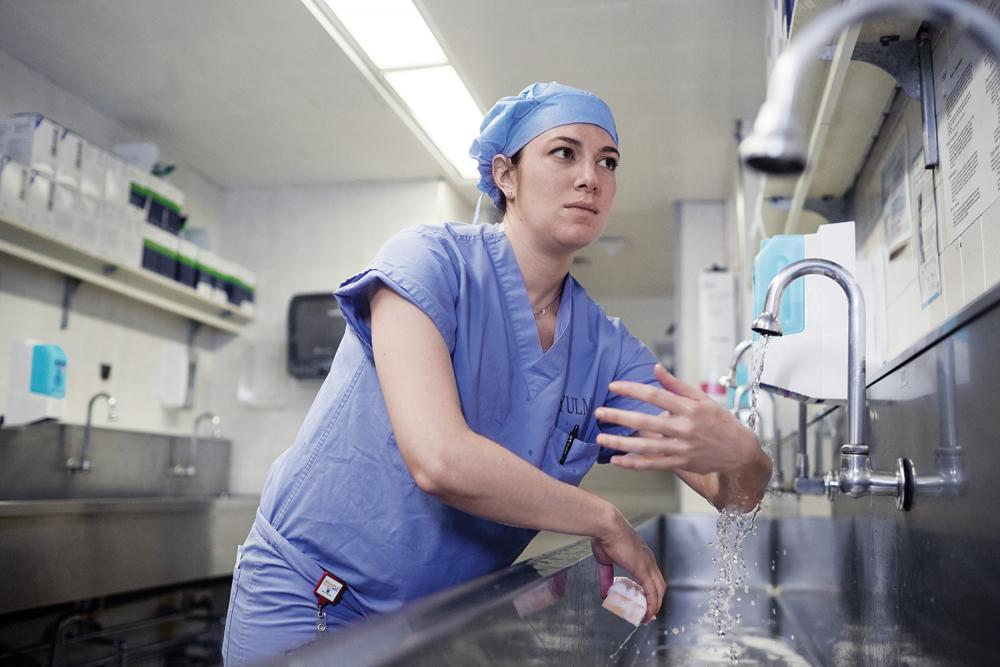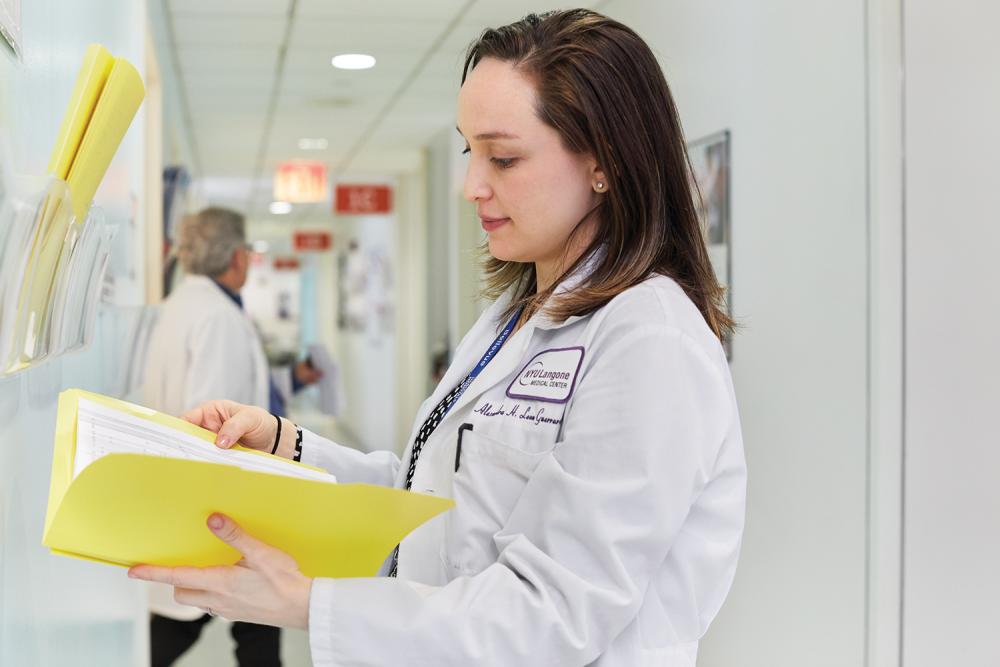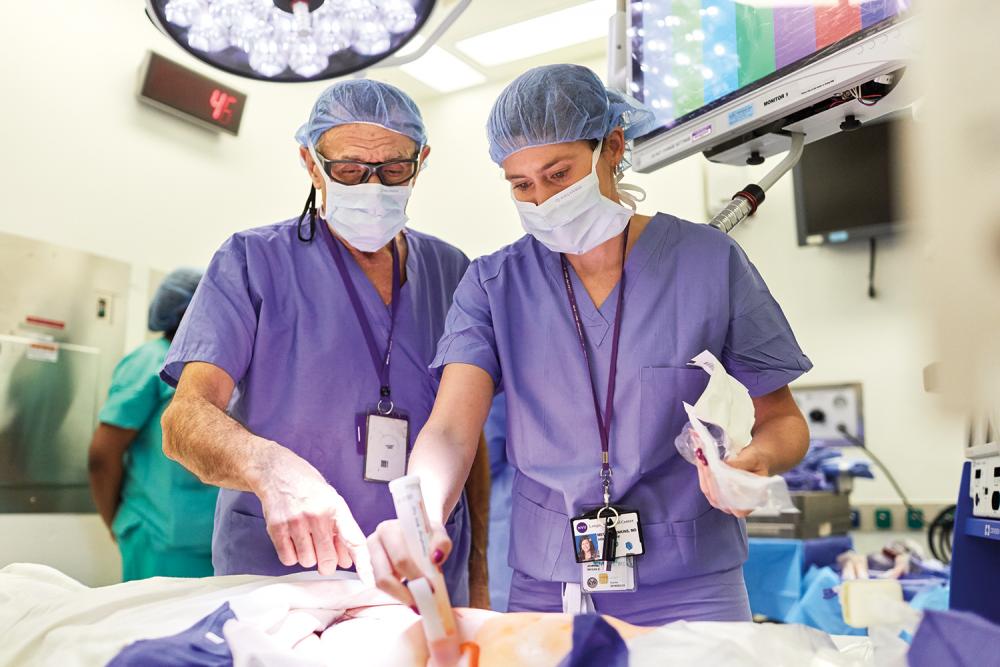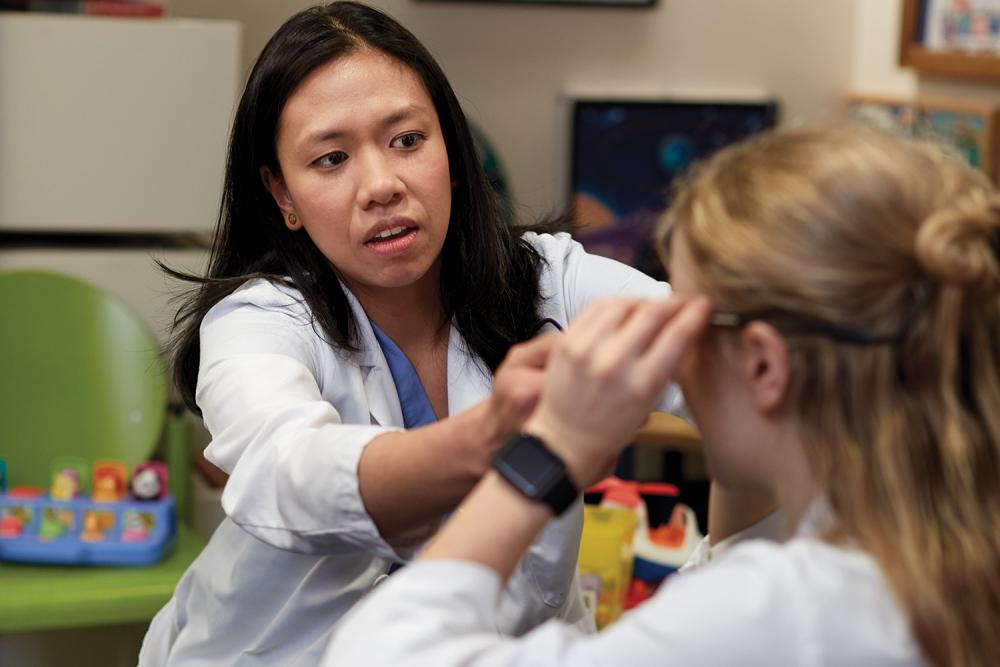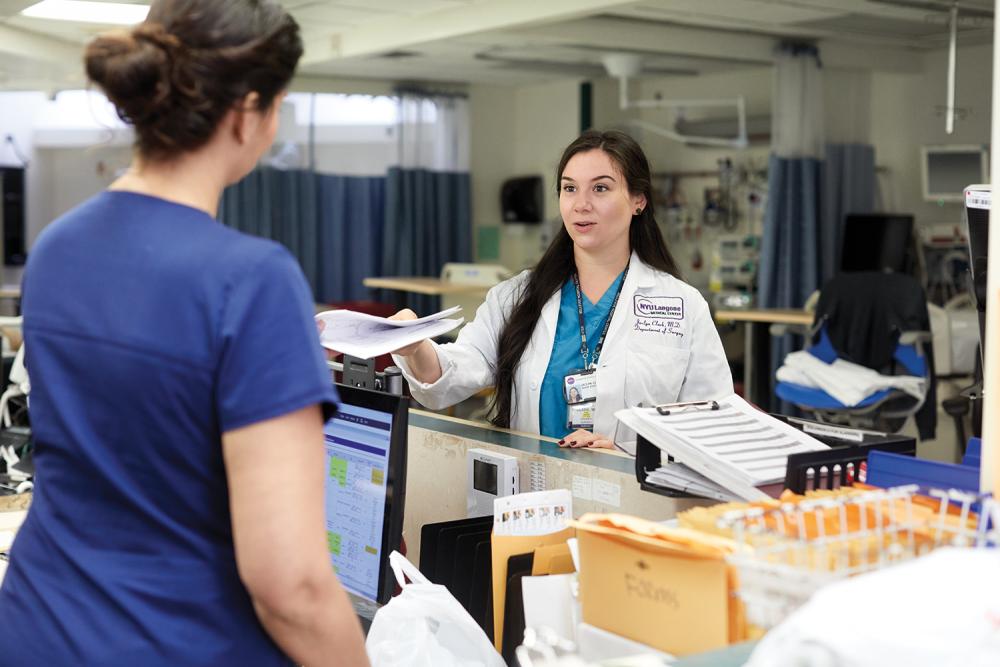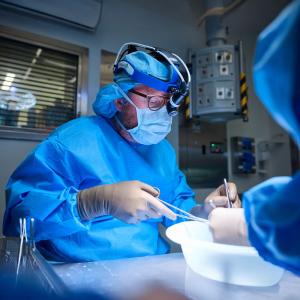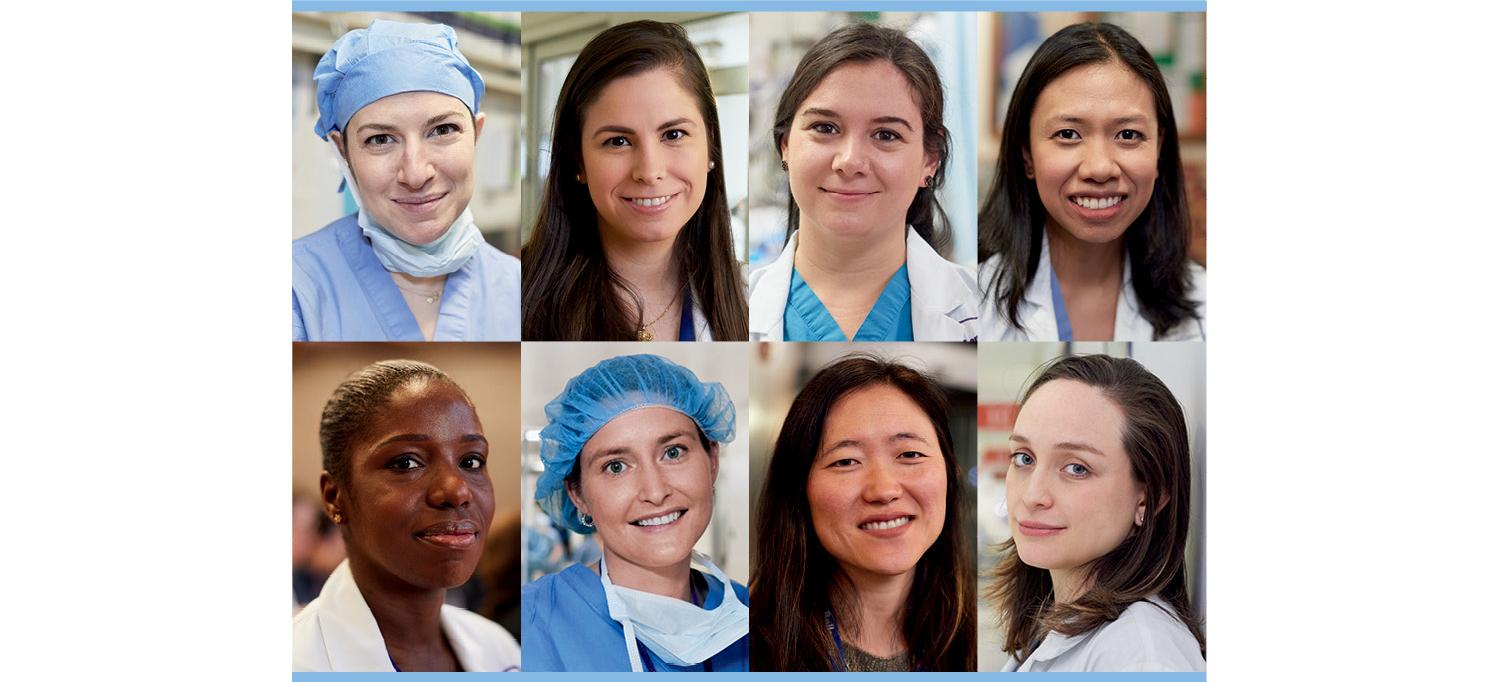
The eight chief residents in the Department of Surgery.
Photos: Jonathan Kozowyk
Many milestones are overstated. This one is simply overdue: For the first time in NYU School of Medicine’s history, the entire group of chief residents in the Department of Surgery—eight in all—are women. “This historic class reflects a slow but inexorable change in our nation’s attitude about which fields in medical science women can pursue,” says H. Leon Pachter, MD, the George David Stewart Professor of Surgery and chair of the Department of Surgery.
Nationwide, the percentage of female surgeons has inched up from 12 percent in 1980 to 19 percent in 2018. NYU School of Medicine is committed to doing better. The school has a long tradition of nurturing women in science and medicine—women have been on the faculty since 1891 and enrolled as students since 1919—but this latest landmark isn’t about any single institutional initiative. Rather, it’s a reflection of the skill, drive, and commitment of these eight young surgeons who will soon make their mark in a variety of surgical subspecialties and settings.
“We appointed the most qualified, competent people for these positions,” says Dr. Pachter. “It’s about merit, not gender.”
Minimally Invasive Surgeon Mia Shapiro, MD
Frogs and therapists—those might be the main reasons Mia Shapiro, MD, went into medicine. The frogs lived in the pond on her family’s 25-acre property in upstate New York, where Dr. Shapiro spent hours catching and studying tadpoles. Her parents were psychotherapists who dedicated their lives to helping others. They taught Dr. Shapiro that her career should include some form of service. “Medicine felt like the right fit,” she says. “I could use my love of science and still help people.”
After majoring in biology at Oberlin College, Dr. Shapiro did research in cardiology—the specialty she thought she’d choose—at the University of California, San Francisco. She then attended Albert Einstein College of Medicine, where she began to see herself as a surgeon. “I’ve always liked working with my hands, doing photography and painting,” she says. “Surgery allows me to be a little artistic, not just cerebral. As a surgeon, it feels amazing to be able to have such a huge impact on someone’s life.”
Dr. Shapiro chose NYU Langone Health for her residency in general surgery because of the diversity of New York City and its patient population. “You see a lot of different kinds of pathology, and you treat people from all different cultures and backgrounds,” she says. “It gives you a good base to work from in the future.”
Her next move is to Providence, Rhode Island, where she’ll begin a fellowship in minimally invasive surgery at Brown University.
General Surgeon Rachel Webman, MD
“I was not someone who went to college intending to be pre-med,” says Rachel Webman, MD. At Yale University, she initially planned to pursue engineering, but after a friend encouraged her to take an emergency medical technician (EMT) course, she realized she could direct her aptitude for math and science toward helping people.
As an undergraduate, Dr. Webman became one of the first volunteers at Yale’s free clinic, dedicating herself to working with the uninsured—a population she has continued to serve during her time at NYU School of Medicine.
“You’re not just helping sick people,” she says. “You’re helping sick people who might not otherwise get that care.”
Dr. Webman chose general surgery as much for its breadth and variety of procedures as for the way it made her feel. “It was the one rotation where, even though I was waking up at 5:00AM, I was excited to get to work and see how my patients were doing after an operation,” she says.
Surgery is also a portable skill, one she intends to put to good use doing humanitarian work abroad. For now, though, she is seeking a general surgery position in the Northeast. “My life is here, and my family is here,” she says.
Surgical Oncologist Donnele Daley, MD
“Growing up in Jamaica, I was always interested in medicine,” explains Donnele Daley, MD, whose mother was a child psychologist and whose father was an economist. “During holidays and summer breaks, I would volunteer in hospitals, especially children’s hospitals.” But Dr. Daley was also interested in physics and math, so she ventured to the United States, where she felt she had the best opportunity to pursue both passions. She entered a five-year dual-degree program, earning a Bachelor of Science degree in physics and math at Vassar College and a Bachelor of Engineering degree at Dartmouth College.
At Dartmouth, Dr. Daley worked with surgeons to reconfigure a device to correct sunken chest in children that was safer and more efficient than existing ones. That experience sparked her interest in surgery. “I realized that I preferred to be the one implanting the devices rather than the one designing them,” she says.
She chose Penn State College of Medicine for its bioengineering department within the medical school, then did her residency at NYU Langone, where she conducted research on immunotherapy in solid tumors. “I wanted to train at a place where I could treat patients from a broad range of cultures and develop a deeper understanding of their unique healthcare needs,” she explains. “If I decide to go back to Jamaica or practice elsewhere, I want to feel comfortable treating anyone.”
For now, Dr. Daley will pursue a fellowship in surgical oncology at Memorial Sloan Kettering Cancer Center, where she’ll continue her research in tumor immunology to help identify targets for new cancer drugs.
Minimally Invasive Surgeon Alexandra H. Leon Guerrero, MD
In 1972, Dr. Alexandra Leon Guerrero’s grandfather founded the Bank of Guam, a community institution dedicated to helping the people of the Micronesian island. “He instilled the idea of service to the community,” says Dr. Leon Guerrero, who was born in San Francisco while her father was finishing his Master of Business Administration degree at Stanford University, but raised in Guam. “That’s something I’ve always valued.”
While virtually everyone else in her family works at the bank, Dr. Leon Guerrero knew she wanted to do something different. But what that would be, exactly, remained a mystery until she was an undergraduate at Stanford.
While there, two life-altering things happened: She became enchanted by science courses, and her father was diagnosed with a rare form of head and neck cancer. “I spent a lot of time with him and my mom going to doctors, and I became much more interested in medicine,” she says.
Dr. Leon Guerrero is headed to the University of Southern California to begin a fellowship in minimally invasive surgery, which she feels is the best way to bring advanced medicine back home. “My long-term goal,” she says, “has always been to return to Guam,” which suffers from many of the same healthcare deficiencies as rural America. She notes that there are far too few specialists, and only a handful of surgeons, to serve the island’s 160,000 residents.
Her training will allow her to perform advanced laparoscopic surgeries as well as much needed endoscopies and colonoscopies—procedures performed by gastroenterologists in the United States but often by general surgeons in underserved areas. “My expertise will help me bring a new standard of care to Guam,” she says. “I really love operating, and what better place to do that than in a community where I care about making a difference.”
Plastic Surgeon Gabriela Garcia Nores, MD
Back in high school, Gabriela Garcia Nores, MD, spent summer vacations shadowing her two uncles, both orthopedic surgeons, in Buenos Aires and Córdoba, Argentina. “I remember watching one of my uncles reconstruct a hip,” says Dr. Garcia Nores. “It changed the patient’s life.” It changed hers, too.
Dr. Garcia Nores, who was born in Peru but spent most of her childhood in France due to political unrest in her native country, learned the value of civic engagement from her mother, founder and president of Instituto Trabajo y Familia, an organization that seeks to improve the living conditions of Peruvian families living at high elevation. During medical school in Lima, Dr. Garcia Nores volunteered for surgical missions around the country, traveling to remote areas with virtually no medical care.
“I had the opportunity to meet and learn from wonderful medical professionals from all over the world,” she says. Her work with Smile Train and Smile Network, which provide facial reconstructive surgeries to people in the developing world, was particularly inspiring. “That’s where I began to see the transformative power of reconstructive plastic surgery.”
Dr. Garcia Nores hopes to return to Peru someday to launch a reconstructive plastic surgery clinic in Lima, where there’s little surgical training in the field, and nearly all plastic surgeons work in private practice, focusing on more lucrative cosmetic procedures. “Having seen the wonderful potential of reconstructive surgery, I want to be able to provide those options to Peruvian patients,” she says. But first, she’s off to a plastic surgery fellowship at Emory University in Atlanta, Georgia.
Minimally Invasive Surgeon Megan Jenkins, MD
Growing up in a small town in central New York State, Megan Jenkins, MD, had two dreams: becoming a doctor and living in the Big Apple. “I yearned for the hustle and bustle of the city,” she says.
She’s achieved both at NYU School of Medicine. What changed was her specialty. “I always thought I’d go into pediatrics,” says Dr. Jenkins, who idolized her own pediatrician. But during medical school, she fell in love with the fast pace and excitement of surgery. “There’s very little downtime,” she says.
“Decisions are made very quickly, and your day is full of action.”
She was also drawn to the collaborative spirit. “Surgery, more than any other specialty, is very team oriented,” she says. “You work with circulating nurses and technicians and anesthesiologists. It’s very dynamic.”
Minimally invasive surgery, with its sophisticated tools, seemed like a natural outgrowth of the engineering classes she took at the University of Rochester, where she majored in biochemistry. Dr. Jenkins will go on to a fellowship at Hackensack Meridian Health in New Jersey.
Pediatric Colorectal Surgeon Iris Lim, MD
Irene Isabel Lim, MD—“Iris” to friends and family—has long understood how to adapt to difficult circumstances. At age 6, her family left Quezon City, Philippines, for the suburbs of New York. “We were the first Asian family at my school in Rye,” says Dr. Lim. “I was picked on because of that, but it toughened me up.” The hurdles Dr. Lim faced as a child gave her a unique perspective on the value of resilience.
But it was another experience that set her on the path toward medicine.
When Dr. Lim was 8, her parents learned that Iris’s new brother might be born with omphalocele, a rare defect in which the abdominal wall fails to close, exposing the organs. Her brother’s condition ultimately resolved in utero, but the ordeal sparked her enduring fascination with surgery.
Dr. Lim majored in engineering at Cornell University and then enrolled at NYU School of Medicine. In July, she began a fellowship in pediatric colorectal surgery at Cincinnati Children’s Hospital Medical Center.
Dr. Lim’s ultimate goal is to give her career what she calls “an international spin.” She recently joined colleagues on a trip to Zambia, where Mary Ann Hopkins, MD, associate professor of surgery and director for global health initiatives, is partnering with the University Teaching Hospital in Lusaka to build an adult trauma registry and create a collaborative research program.
The project perfectly unites Dr. Lim’s passion for surgery and humanitarian work. “Being able to do surgery is one way of giving back for all that I’ve been given,” she says.
Trauma Surgeon Jaclyn Clark, MD
At age 3, while most other kids were clinging to stuffed animals, Jaclyn Clark, MD, had her doctor’s kit. That was the year her baby cousin was born with brain cancer. “I grew up knowing I was going to be a doctor,” says Dr. Clark, from Bergen County, New Jersey. “There was never any other career path I wanted to explore.”
In her teenage years, Dr. Clark worked as an EMT but didn’t enjoy it. So she was more surprised than anyone when, after majoring in biology and history at Johns Hopkins University and enrolling at NYU School of Medicine, she ultimately decided to go into critical care, trauma, and acute-care surgery.
“Trauma is the last thing I ever thought I’d do,” she says, “but I love the adrenaline and knowing how to handle an injury anywhere in the body.”
Dr. Clark also likes being the person called in as a last resort—the cool head in an emergency situation. “I can deal with anything that comes my way,” she says. It’s the ideal mindset for the next phase of her training—a fellowship at the University of Maryland Medical Center’s R Adams Cowley Shock Trauma Center in Baltimore.
